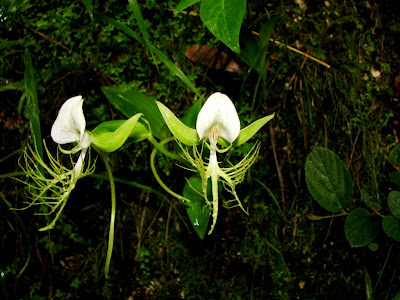Habenaria intermedia

Habenaria intermedia D. Don
Family: Orchidaceae.
Description: It is a terrestrial orchid, perennial with a
tuberous rootstock. Stems arise annually, leafy, somewhat flexuous. Plants
typically reach about 50‑75 cm
height. Leaves: 2‑4 leaves, sheathing at base; leaves are ovate to ovate‑lanceolate
or elliptic, acuminate, 5‑10 × 4.5 cm approximately. Veining 5‑7‑nerved. Inflorescence
/ Flowers: Raceme up to 20‑25 cm long, dense, bearing several (3‑6) flowers.
Flowers greenish‑white to white; sepals and petals forming a hood; lip 3‑lobed
with spur, lateral lobes pectinate (filiform segments), mid‑lobe simple linear‑oblong;
spur stout, exceeding ovary in many cases. Flowering from about June to
September.
Distribution (World & India): Global / general: Found in
Himalayas (Nepal, China/Tibet, Pakistan, Bhutan), and northeastern India. Altitude
range: Approximately 1,500 to 3,300 m above sea level
(some sources give ~1,800‑2,900 m for Indian Himalayas). In India: Found in
temperate Himalayan regions: Jammu & Kashmir, Himachal Pradesh,
Uttarakhand, Sikkim, NE India. Occurs in open grassy slopes, open meadows,
grasslands.
IUCN Status / Conservation: The species is considered Endangered in IUCN context
per some sources. Threats include overharvesting of tubers (for medicinal
usage), habitat loss and degradation, low seed germination / seedling
establishment, and general pressures on Himalayan orchids.
Medicinal Properties & Traditional Uses (in
India): Chemical
Constituents: Phytochemicals identified: flavonoids, tannins, steroids, coumarin
glycosides; also phenolic compounds such as gallic acid, hydroxyl benzoic acid.
Pharmacological
/ Therapeutic Effects:
|
Use |
Details / Mode of Use |
|
Rejuvenative
/ tonic (Rasayana) |
Part of
“Astavarga” group of tonic herbs; used in Chyawanprash and other rejuvenating
tonic formulations. |
|
Immune‑booster
/ Antioxidant |
Strong
antioxidant potential has been demonstrated in studies; capacity for free
radical scavenging. |
|
Aphrodisiac
/ Brain tonic / Intellect Promoter |
Tubers
are used in traditional medicine for enhancing cognitive function, sexual
vitality. |
|
Depurative
/ Detoxifying |
Used to
purify blood / body fluids; skin diseases; leprosy. |
|
Respiratory
conditions |
Used in
asthma. |
How it’s Used (Preparation, Parts, Varieties): Part used: Primarily the underground tubers (kanda); also
young leaves edible and used. Preparation: Harvesting done after
fruiting / when stalk and leaves are dried (around October). Tubers are
collected; sometimes cooked as vegetable; used in polyherbal formulations.
Storage of tubers may be done by burying in soil, storing in sand, or pits
during winter. Varieties: No clearly documented botanical varieties in the
sources consulted. Morphological variation exists but no formal varietal
classification found.
Uses in India (Examples): Constituent of Ashtavarga,
an eight‑herb Rasayana group in Ayurveda. Used in Chyawanprash
traditional tonic. Used as brain tonic, aphrodisiac; for skin diseases; asthma;
leprosy; also edible tubers and leaves.


Comments
Post a Comment